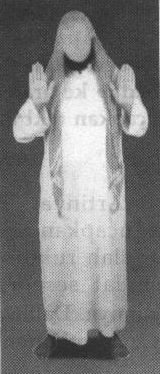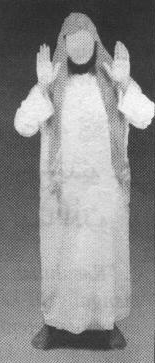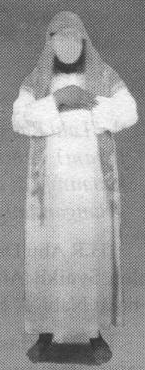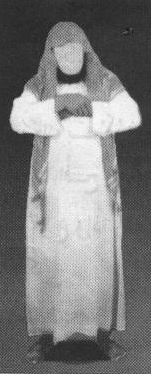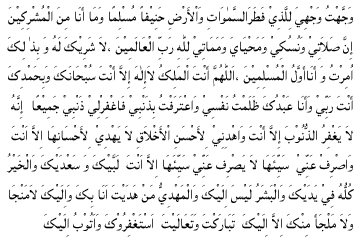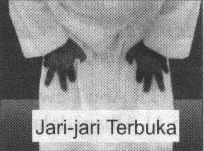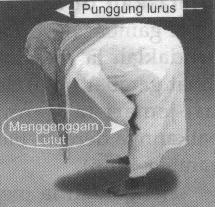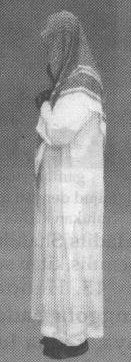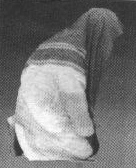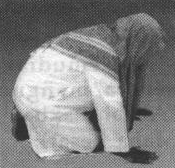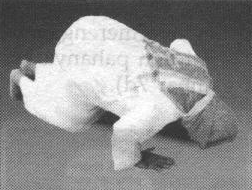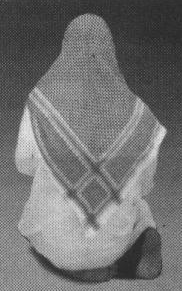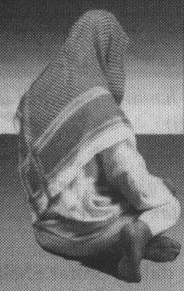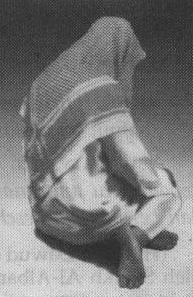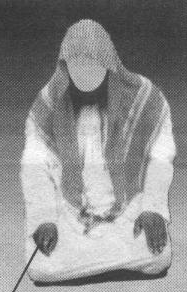Prophet sallallaahu 'alaihi wasallam doing fard or sunnah prayers stand as fulfilling God's command in Sura. Al-Baqarah: 238. When traveling, he did sunnah prayers over the vehicle. He teaches his people to perform prayers khauf on foot or driving.
"Keep all the prayers and the prayers Wustha and stand quietly for God. If you are in fear, sholatlah by walking or driving. If you are in a safe Keadaa, remember to God in a way that has been taught to you that which you did not previously know (that way). "(Surat al-Baqara: 238).
FACING Kaaba
Prophet sallallaahu 'alaihi wasallam when standing for prayers fard or sunnah prayers, he overlooks the Kaaba. He was ordered to do so as his saying one prayer to those who:
"When you stand for prayer, complete the wudhu'mu, then menghadaplah to a direction, then bertakbirlah."
(Narrated by Bukhari, Muslim and Siraj).
On this point also the word of God has come down in Surah Al-Baqarah: 115:
"Where have you been confronted face, there is the face of God."
The Prophet sallallaahu 'alaihi wasallam prayed facing Baitul Maqdis ever, this happened before the revelation of the word of God:
"We've seen you raise your head to the sky. We palingkan you to a direction that you want. Therefore, hadapkanlah face to partially towards the Haram. "(Surat al-Baqara: 144).
After this verse was his prayer facing the Kaaba.
At the time of the morning prayer of the Muslims who lived in Quba 'the arrival of a messenger of the Prophet to deliver the news, he said,
"In fact last night the Prophet sallallaahu 'alaihi wasallam had a premonition, he was told to face the Kaaba. Therefore, (let) you facing there. "By that time they were facing Sham (Baitul Maqdis). They then spinning (they rotate the priest so that he lead the turnaround they facing the Qiblah). (Narrated by Bukhari, Muslim, Ahmad, Siraj, Tabarani, and Ibn Sa'd. Read the Book Al Irwa ', Hadith No.. 290).
FACING sutrah
sutrah (barrier located in front of the praying people) in prayer becomes imperative priests and people who pray alone, even in a large mosque, according to the opinion of Ibn Hani 'in the Book Masa'il, from Ahmad.Beliau Imam said, "One day I pray without installing sutrah in front of me, but I do pray in our mosques, Imam Ahmad saw the incident, and said to me, 'Put something as sutrahmu!' Then I put up the to be sutrah. "Shaykh Al-Albani said," This incident is a sign of Imam Ahmad that people who pray in mosques large or small mosques remain obligated sutrah put in front of him. "Prophet sallallaahu 'alaihi wasallam said:
"Do not pray without facing sutrah, and do not let anyone pass in front of you (without you prevent). If he continues to force passes in front of you, kill him because he was accompanied by the devil. "
(Narrated by Ibn Khuzaimah with jayyid isnaad (good)).
He also said:
"If one of you pray facing sutrah, let him approach sutrahnya so demons can not break the prayer."
(Narrated by Abu Dawood, Al-Bazzar and Hakim. Adopted by the judge, if approved Dhahabi and Nawawi).
And let sutrah was placed not too far from where we stood praying as has been exemplified by the Prophet sallallaahu 'alaihi wasallam.
"The Prophet sallallaahu 'alaihi wasallam stood praying near sutrah (limiting) the distance between him and the barrier 3 feet in front of him."
(Narrated by Bukhari and Ahmad).
As for who can be sutrah include: pole mosque, spear driven into the ground, animal mounts, saddle, saddle height poles, trees, beds, walls and other similar one, as exemplified by the Prophet sallallaahu 'alaihi wasallam.
Intention
Intention means menyengaja for prayer, devote themselves to Allaah alone, as well as reinforcing the hati.Nabi sallallaahu 'alaihi wasallam said:
"All the charity depends on the intentions and every person will get (children) in accordance with his intention."
(Narrated by Bukhari, Muslim and others. Read Al Irwa ', hadith no. 22).
Intention not dilafadzkan
And not mentioned from the Prophet sallallaahu 'alaihi wasallam nor from one of his friends that the intention was dilafadzkan.
Abu Dawood said to Imam Ahmad. He said, "Do people pray say something before he Takbeer?" Imam Ahmad replied, "No." (Imam Ahmad al Masaail terms of 31 and Majmuu 'al Fataawaa XXII/28).
AsSuyuthi said, "including acts of heresy is alarmed (always doubt) as intending to pray. It was never done by the Prophet sallallaahu 'alaihi wasallam and the Companions him. They never used to saying the prayer intentions at all besides just lafadz takbir. "
Ash-Shafi'i said, "Was-was the intention of the prayer and the thaharah including ignorance of the law or confusing sense." (See al-Amr bi al Itbaa 'wa al Nahy' an al Ibtidaa ').
Takbiratul ihromProphet sallallaahu 'alaihi wasallam always start the prayer (performed only once when they wanted to start a prayer) with takbiratul ihrom ie saying Allahu Akbar (  ) at the beginning of the prayer, and he was never ordered such a prayer to the wrong people. He said to the man:
) at the beginning of the prayer, and he was never ordered such a prayer to the wrong people. He said to the man:
"Verily, the prayer is not a perfect person before he wudoo 'and do wudu' suit provisions, then he say Allahu Akbar."
(Hadith narrated by Imam Al-Tabarani with a saheeh isnaad).
Prophet sallallaahu 'alaihi wasallam said:
"If you want to do the prayer, then complete the first wudhu'mu then menghadaplah towards Qibla and recite takbiratul ihrom."
(Agreed upon).
Takbirotul ihrom pronounced with oral
Takbirotul ihrom should be pronounced with the tongue (not pronounced in the liver).
Muhammad Ibn Rushd says, "As someone who reads silently, without moving his tongue, then it was not called by reading. Because reading is called the melafadzkannya in the mouth. "
An Nawawi said, "... as for other than the priest, then disunnahkan him to not turn up the volume when reading lafadz veil, whether he is becoming his own congregation or when praying. The voice harden not if he does not encounter obstacles, such as the sound of a very rowdy. Minimum limit is slow voice could be heard by himself if his hearing is normal. It generally applies both when reading the verses of al Qur'an, Takbir, read the rosary when bowing, tasyahud, greetings and prayers in both obligatory prayers and sunnah ... "he continued," So nash proposed Shafi ' i and agreed upon by his followers. Ash-Shafi'i said in al-Umm, 'Let yourself be heard, and people who are on the side. Not worth it to add volume over that size. '. "(Al Majmuu' III/295).
SECOND HAND LIFTdisunnahkan raised his hands when bertakbir setentang shoulder with his fingers pressed,
based on the hadith narrated by Abdullah ibn Umar Radiyallahu anhuma, he said:
"Prophet sallallaahu alaihi wasallam raised his hands setentang usual shoulder if you want to start a prayer, every time bertakbir for bowing and every time rose from ruku'nya."
(Agreed upon).
Or raised his hands setentang ears,
hadith narrated by Malik bin Al-Huwairits radhiyyallahu anhu, he said:
"Prophet sallallaahu 'alaihi wasallam raised his hands setentang ordinary ears every time bertakbir (in the prayer)."
(Narrated by Muslim).
In a hadith narrated by Abu Dawud, Ibn Khuzaimah, Tamam and Judge mentioned that the Prophet sallallaahu 'alaihi wasallam raised his hands with open fingers straight up (not merenggangkannya nor menggengamnya). (Shifat prayer of the Prophet).
Crossed
Then the Prophet sallallaahu 'alaihi wasallam put his right hand over his left hand (folded). He said:
"We, the prophets were ordered to immediately and mengakhirkan breaking dawn and put his right hand on the left hand (folded) when to pray."
(Hadith narrated by Al-Imam Ibn Hibban and Adh Dhiya 'with a saheeh isnaad).
In a history once he passed a man who was praying, but this guy put his left hand on his right hand, and then he let go, then the man put his right hand on his left hand. (Narrated by Ahmad and Abu Dawood with a saheeh isnaad).
Laying or grasping
He sallallaahu 'alaihi wasallam put his right arm on the back of the palm of his left wrist and his left arm
based on the hadith of Wail bin Hujur:
"Then the Prophet sallallaahu 'alaihi wasallam bertakbir then put his right hand on the palm of the left hand, left wrist or the left arm."
(Hadith narrated by Al-Imam Abu Dawud, Nasa'i, Ibn Khuzaimah, with a saheeh isnaad and dishahihkan also by Ibn Hibban, hadith no. 485).
He sometimes also grasped his left wrist with his right hand,
based on the hadith Nasa'i and Daraquthni:
"But he is sometimes stretched out the fingers of his right hand on his left arm."
(saheeh sanad).
Crossed on the chest
Menyedekapkan hands on the chest is the right thing according to the Sunnah of the hadeeth:
"He put his hands on his chest."
(Hadith narrated by Al-Imam Abu Dawud, Ibn Khuzaimah, of Wail bin Ahmad Hujur).
Appropriate ways Sunnah is done by Imam Ishaq bin Rahawaih. Imam Mawarzi in Masa'il Book, page 222 says: "Imam Ishaq mutawatir narrate it to us .... He raised his hands when praying and doing qunut sebeluim qunut bowing. He menyedekapkan hand adjacent to the tits. "This sort of opinion is also stated by Qadi 'Iyad al-Maliki in the ash Mustahabatu chapter in the book of Al I'lam prayer, he said:" He put his right hand on the back of the left hand on the chest. "
LOOKING place of prostration
At the time of doing the prayer, the Prophet sallallaahu 'alaihi wasallam bowed his head and directed his gaze to the place of prostration. It is based on the hadith narrated by Ummul Mu'mineen 'Aisha radi' anha:
"Prophet sallallaahu 'alaihi wasallam did not take his eyes from the place of prostration (in prayer)."
(Narrated by al-Bayhaqi and classed as saheeh by Shaykh Al-Albani).
Prohibition looking up to heaven
the Prophet sallallaahu 'alaihi wasallam forbade looked up to the sky (when praying). From Abu Hurayrah radi 'anhu, that the Prophet sallallaahu' alaihi wasallam said:
"Let a group of people actually stop her eyes lifted to the sky while praying in a prayer or let them really keep their eyes."
(Narrated by Muslim, Nasa'i and Ahmad).
Prophet also prohibits a person turns to the right or to the left when the prayer, he said:
"If you pray, do not turn to the right or to the left because God will always exposes his face to the servant who was praying while he did not turn to the right or to the left."
(Narrated by al-Tirmidhi and Hakim).
In Zaadul Ma'aad (I/248) stated that legal makruh people who were praying turned his head without any purpose. Ibn Abd al-Bar said, "Jumhur scholars say take turns light does not cause prayers to be damaged."
Also dimakruhkan praying in the concentration of something that can damage or where there are the pictures, above the existing mat painting or carving, in front of a wall with a picture and so on.
READING Benediction ISTIFTAH
istiftah Prayer is read by the Prophet sallallaahu 'alaihi wasallam manifold. In the istiftah prayer he sallallaahu 'alaihi wasallam utter praise, flattery and grandeur to Allah.Beliau sentence ever ordered it to those who perform the prayer wrong with his saying:
"No one's perfect prayer before he bertakbir, utter praise, saying the sentence majesty (istiftah prayer), and read the verses of al Qur'an memorized ..." (Narrated by Abu Dawood and Hakim, endorsed by the judge, approved by Dhahabi).
As reading prayer istiftah taught by the Prophet sallallaahu 'alaihi wasallam are:
"ALLAHUUMMA BA'ID BAINII WA Baina KHATHAAYAAYA KAMAA BAA'ADTA Bainal MASYRIQI WAL Maghreb, ALLAAHUMMA NAQQINII MIN KHATHAAYAAYA KAMAA YUNAQQATS TSAUBUL ABYADHU MINAD Danas. ALLAAHUMMAGHSILNII MIN KHATHAAYAAYA BIL MAA'I TSALJI WAL WATS BARADI "
meaning:
"Yes, God, keep between me and my mistakes as you keep between east and west.Yes, Allah, purify me from my mistakes as a white dress is cleaned of impurities. Yes, God wash me from my mistakes with water, snow and dew. "(Narrated by Bukhari, Muslim and Ibn Abi Syaibah).
Or sometimes the Prophet sallallaahu 'alaihi wa sallam also read the fard prayer:
"WAJJAHTU WAJHIYA LILLADZII FATARAS SAMAAWAATI WAL Ardha HANIIFAN [MUSLIMAN] WA MAA ANA MUSYRIKIIN terminal. INNA SHOLATII WANUSUKII WAMAHYAAYA WAMAMAATII lillahi Rabbil 'alamiin. LAA SYARIIKALAHU WABIDZALIKA UMIRTU WA ANA AWWALUL MUSLIMIIN. Allahumma ANTAL MALIKU, La ilaha illa ANTA [SUBHAANAKA WA BIHAMDIKA] Rabbee WA ANTA ANA 'ABDUKA, DHALAMTU NAFSII, WA'TARAFTU BIDZAMBI, FAGHFIRLII DZAMBI JAMII'AN, INNAHU LAA YAGHFIRUDZ DZUNUUBA Illa ANTA. WAHDINII AHSANIL AKHLAAQI LAA LI LI YAHDII AHSANIHAA illa ANTA, WASHRIF 'ANNII SAYYI-ahaa LAA YASHRIFU' ANNII SAYYI-ahaa Illa LABBAIKA WA ANTA SA'DAIKA, WAL khairu KULLUHU FII YADAIKA. Wasy SYARRULAISA ILAIKA. [MAN WAL MAHDIYYU HADAITA]. ANA BIKA WA ILAIKA [LAA MANJAA walaa MALJA-A Illa Minka ILAIKA.TABAARAKTA WA TA'AALAITA ASTAGHFIRUKA WAATUUBU ILAIKA "
which means:
"I confronted my face to the Creator of the heavens and the earth with full submission and I'm not including the polytheists. My prayer, my worship, my life and my death solely for Allah, the Lord of the Worlds, there is no such thing his ally. Thus I ruled and I am among those who first became Muslim. O God, thou art the ruler, there is no god but You alone. [Thou Glorified and Mahaterpuji], You Rabbku and me thy servant, I have wronged myself, and I confess my sins , so forgive all my sins. Surely You alone are entitled to forgive all sins. Grant me the instructions to the morality of the best, because you are the only who can guide the morality of the best and put away my bad manners. Thee I answered the call, and they all ugliness does not come from you. [The person is the one who guided you give instructions]. I be in thy power and will get back to you, [no place of safety and beg thy protection from the punishment but only you alone]. You and Sovereign of glory, I beg your forgiveness and repent to You. "
(Hadith narrated by Imam Al-Bukhari, Muslim and Ibn Abi Syaibah)
TA'AWWUDZ READING
Reading is disunnahkan ta'awwudz prayer in every rak'ah, as Allah ta'ala:
"When you recite the Qur'an be ye seek refuge in Allah from the accursed Satan." (An-Nahl: 98).
And this opinion is the most authentically in the Shafi'i madhhab and reinforced by Ibn Hazm (See al Majmuu 'III/323 and Tamaam al Minnah 172-177).
Prophet used to read ta'awwudz which reads:
"A'UUDZUBILLAHI MINASY SYAITHAANIR rajeem MIN HAMAZIHI WA NAFKHIHI WANAFTSIHI"
meaning:
"I seek refuge in Allah from the accursed devil, from the eruption (which menyebabkn crazy), of pride, and of hembusannya (which causes damage to morality)."
(Hadith narrated by Al-Imam Abu Dawud, Ibn Majah, Daraquthni, Justice and by him dishahkan and by Ibn Hibban and Dhahabi).
Or say:
"A'UUZUBILLAHIS SAMII'IL ALIIM MINASY SYAITHAANIR rajeem ..."
meaning:
"I seek refuge in Allah the All-Hearing, All-Knowing from the accursed devil ..."
(Hadith narrated by Al-Imam Abu Dawud and Tirmidhi with a hasan isnaad).
READING Al-Fatiha
Al-Fatihah Law Reading
Reading Al-Fatihah is one of the many pillars of prayer, so that the prayer does not read Al-Fatiha then his prayer is not valid based on the words of the Prophet sallallaahu 'alaihi wa sallam (which means):
"Not considered prayer (not unauthorized prayer) for those who do not read Al-Fatihah"
(Sahih Hadith issued by Al-Jama'ah: the Al-Imam Al-Bukhari, Muslim, Abu Dawud, At-Tirmidhi, An-Nasa-i and Ibn Majah).
"Those who pray without reading Al-Fatiha then his prayer stump, stump prayer, his prayer is not perfect stump ..."
(Sahih Hadith issued by Al-Imam Muslim and Abu 'Awwanah).
When Do We Mandatory Reading Surat Al-Fatiha
is clear to us when he was praying alone (munfarid) then it is obligatory to read al-Fatiha, so did the congregation when the priest read prayers are sirr (not heard) that the Dhuhr prayer, 'Asr, roka'at Mahgrib one last prayer and two roka'at last prayers' Isyak, then the congregation must read Al-Fatiha is individually are sirr (not hardened).
So what if the priest read aloud ...?
About the Shaykh Al-Albani said that Prophet never forbade congregation behind the imam reads the letter except Al-Fatiha:
"Is it true you had read (letters) imam behind you?" We replied: "Yes, but quickly, O Allah's Apostle." Says the apostle: "You must not discriminate
READING AMIN
Law For Priest:
Reading disunnahkan for priests pray amen.
From Abu Hurairah, he said: "The Prophet sallallaahu 'alaihi wa sallam, when finished reading the letter Ummul Kitab (Al-Fatiha) to raise his voice and read amen."
(Hadith issued by Imam Ibn Hibban, al-Hakim, al-Bayhaqi, Ad-Daraquthni and Ibn Majah, Al-Albani in Al-Lineage Al-Shahihah said to be qualified hadeeth saheeh)
"When the Prophet finished reading Al-Fatihah (in prayer), he was saying ameen loudly and long."
(Saheeh Hadith issued by Al-Imam Al-Bukhari and Abu Dawud)
The hadith mensyari'atkan priests to harden reading amin, therefore the opinion of Al-Imam Al-Bukhari, As-Shafi'i, Ahmad, Ishaq and other priests jurisprudence. In shahihnya Al-Bukhari made a chapter with the title 'Baab al-Imaan jahr bi al-ta-Miin' (meaning: the chapter on the priest raised his voice when reading amin).Words quoted therein (atsar) that Ibn al-Zubayr read amen with the congregation until there seemed to echo in the mosque.
Also the words of Nafi '(Maula Ibn Umar): Ibn Umar used to always read aamiin loud. In fact he recommends it to everyone. I never heard a word about the advice he would be it. "
For congregation Law:
In this case there are some hints of the Prophet (Hadith), atsar the Companions and the words of the scholars.
Prophet sallallaahu 'alaihi wa sallam said: "If the imam reads ameen then let you also read ameen."
This suggests that it is obligatory reading for amiin congregation. This opinion was reinforced by Ash-Syaukani. But it is not absolutely mandatory law to be performed by the congregation. They only required to read ameen when the priest also read it.As for the priests and people who pray alone, the law only sunnah. (See Nailul Authaar, II/262).
"When the priest finished reading ghoiril maghdhuubi 'alaihim waladhdhooolliin, say ameen [because angels say ameen and the imam was saying ameen]. In another narration: "(when the priest says ameen, ameen let you say) whoever aminnya greeting along with angels, (in another narration:" if anyone of you say amen in prayer together with the angels in the heavens say), his sins of the past forgiven. "
(Hadith issued by Al-Imam Al-Bukhari, Muslim, An-Nasa-i and Ad-Darimi)
Shaykh Al-Albani commented on this issue as follows:
"I said: This issue should be taken seriously and should not be underestimated in a way to leave it. Including perfection in doing this problem is to accompany the reading amin imam, and not precede it. (Tamaamul Minnah it. 178)
AFTER READING LETTER Al-Fatihah
read surah Al Qur'an after reciting Al-Fatihah role in legal sunnah prayers because the Prophet sallallaahu 'alaihi wa sallam was not allowed to read it. Read surah Al-Qur-an is performed on the first two roka'at. Many hadith that tells the deeds of the Prophet sallallaahu 'alaihi wasallam about it.
The short length letter reads
munfarid In prayer the Prophet sallallaahu 'alaihi wa sallam read long letters unless ill or busy, while if a priest according to the conditions makmumnya (eg there is a crying baby then shortened reading). Messenger of Allah said:
"I do pray and I would like to extend his reading however, I suddenly heard the sound of a baby crying so I shorten my prayer because I know how anxious mother because the baby was crying."
(Hadith issued by Al-Imam Al-Bukhari and Muslim)
How to read a letter
in the prayer, he sometimes divides into two roka'at one letter, sometimes also the same letter is read on the first and second roka'at. (Based Hadith issued by Al-Imam Ahmad and Abu Ya'la, also issued by the hadeeth of Al-Imam Abu Dawud and al-Bayhaqi or history of Ahmad, Ibn Khuzaimah and Al-Hakim, endorsed by Al-Hakim approved by Ad-Dhahabi)
Sometimes he lets read two letters or more in one roka'at. (Based hadith issued by Al-Imam Al-Bukhari and at-Tirmidhi, declared by al-Tirmidhi as authentic hadith)
The procedure for reading the Prophet sallallaahu 'alaihi wa sallam
Prophet sallallaahu 'alaihi wa sallam used to read the letter by the number of verses impartial between roka'at first to second roka'at. (Based on authentic hadith issued by Al-Bukhari and Muslim)
In the recitation of prayers in the Prophet-jahr-read it out loud and clear. But at midday and Asr prayers also at the maghrib prayer roka'at roka'at last two or three evening prayers' Prophet read quietly that can only be known when the Prophet was reading from the movement of his beard, but sometimes he let out his reading to them, but not as hard such as in-jahr-right. (Based Hadith issued by Al-Imam Al-Bukhari, Muslim and Abu Dawud)
Prophet sallallaahu 'alaihi wa sallam used to read a letter from start to finish is completed. He sallallaahu 'alaihi wa sallam said:
"Give each letter its right, that is in every (roka'at) bowing and prostration."
(Hadith issued by Al Imam Ibn Abi Syaibah, Ahmad and 'Abdul Ghani Al-Maqdisi)
In another narration:
"For every single letter (read) in one roka'at."
(Hadith issued by Al Imam Ibn Nasr and At-Thohawi)
Described by Shaykh Al-Albani: "There should not you read the whole letter in each one of the roka'at roka'at so perfectly on his side." Command in the Hadith Sunnah is not obligatory.
In a letter read Al-Qur'an the Prophet sallallaahu 'alaihi wa sallam did Tartil, not fast nor slow-as commanded by God-and he read one by one sentence, so that the letter takes longer than usual when read ( without sung). Messenger said that people who read Al-Qur'an will eventually called out:
"Read, examine and tartilkan as you first mentartilkan in the world, because your position is in the final paragraph that you read."
(Hadith issued by Al Imam Abu Dawud and At-Tirmidhi, classed as saheeh by al-Tirmidhi)
Prophet sallallaahu 'alaihi wa sallam reciting surat Al-Qur-an with a good voice, so he also ordered such that:
"Perindahlah / adorn Al-Qur'an with your voices [for a good sound adds to the beauty of the Qur-an]."
(Hadith issued by Al-Imam Al-Bukhari, Abu Dawud, Ad-Darimi, and Tamam Al-Hakim Ar-Razi)
"It is not from our group who did not sing the Qur-an."
(Hadith issued by Abu Dawud and Al-Hakim, classed as saheeh by al-Hakim and adh-Dhahabi agreed by)
Bowing
of the Prophet sallallaahu 'alaihi wa sallam as he finished reading the letter from Al-Qur'an then paused, raised his hands as he continues bertakbir like when takbiratul ihrom (setentang shoulders or earlobes) and then bowing (broken crouch next to the waist, with your back straight and parallel to the floor head). Under some hadith, one of which is:
Abdullah ibn Umar, he said: "I saw the Prophet sallallaahu 'alaihi wa sallam when standing in prayer setentang raised his hands to his shoulders, it was done when bertakbir about to bow and when it raises its head (rise) of bowing ...."
( Hadith issued by Al-Imam Al-Bukhari, Muslim and Malik)
How Ruku '
> When the Messenger bowing then he put his hands on his knees, so he also commanded the companions.
"Behold, sallallaahu 'alaihi wa sallam (while bowing) put his hands on his knees."
(Hadith issued by Al-Imam Al-Bukhari and Abu Dawud)
> Stressing his hands on his knees.
"If you bowing then put both hands on your knees and spread Your (straighten) your back and arms to emphasize bowing."
(Hadith issued by Al-Imam Ahmad and Abu Dawud)
> Stretches fingers.
"He stretches his fingers."
(Hadith issued by Al-Imam Al-Hakim and he menshahihkannya, Adh-Dhahabi and al-Thayalisi agree)
> Stretches both elbows of the stomach.
"He when bowing, his back straightened and stretched so that when water is poured over his back, the water will not move."
(Hadith issued by Al Imam Tabarani, 'Abdullah bin Ahmad and Ibn Majah)
> Between the head and back straight, head is not up nor down but the middle between the two conditions.
"He does not rear its head nor subdue it."
(This is narrated by Abu Dawood and Imam Al Bukhari)
"Pray someone perfect before he did bowing and prostration with straightening his back."
(Hadith issued by Al-Imam Abu 'Awwanah, Abu Dawood and classed as saheeh by Ad-Sahmi Daraquthni)
> Thuma-ninah/Bersikap Calm
He never saw people bowing and prostration with imperfect like birds pecking, then said: "If these people die in such circumstances, he died outside of the religion of Muhammad [prayer as a crow pecks food] as the bowing and prostration imperfect quickly like a hungry bird that takes one, two date stones are not filling. "
(Hadith issued by Al Imam Abu Ya'la, Al-Ajiri, Al-Bayhaqi, Adh-Dhiya 'and Ibn Asakir with a saheeh isnaad, classed as saheeh by Ibn Khuzaimah)
> Lengthen Ruku '
"The Prophet sallallaahu 'alaihi wa sallam made bowing, standing after bowing and prostration were sitting between the two prostrations almost the same length."
(Hadith issued by Al-Imam Al-Bukhari and Muslim)
Which Reads When Ruku '
supplication read by the Prophet sallallaahu 'alaihi wa sallam there are several kinds, everything ever read by him so sometimes reading is sometimes the other.
1. Subhaana RABBIYAL 'ADHZIM 3 times or more (Based Hadith issued by Al-Imam Ahmad, Abu Dawud, Ibn Majah and others).
Which means:
"Glory Rabbku, again the Supreme Court."
2. Subhaana RABBIYAL 'ADHZIMI WA BIHAMDIH 3 times (Based Hadith issued by Al-Imam Ahmad, Abu Dawud, Ad-Daroquthni and Al-Bayhaqi).
Which means:
"Glorified and Exalted Rabbku again all praise for him."
3. SUBBUUHUN QUDDUUSUN Lord of MALA-IKATI RUUH WAR (Based Hadith issued by Al-Imam Muslim and Abu 'Awwanah).
Which means:
"Glory, Glory to the Lord of the angels and the spirit."
4. SUBHAANAKALLAHUMMA WA BIHAMDIKA ALLAHUMMAGHFIRLII
Which means:
"Glory to you, O God, and to praise you O God forgive me."
Based on the hadith of 'A-isyah, that he said:
"It is the Prophet sallallaahu 'alaihi wa sallam multiply reading Subhanakallahumma Wa Bihamdika Allahummaghfirlii in ruku'nya and prostration, he mentakwilkan Al-Qur-an."
(Hadith issued by Al-Imam Al-Bukhari and Muslim).
Benediction is most often read. It is said that there is a history of 'A-isyah which indicates that the Prophet since the fall of Surat an-Nasr-which means: "You shall say the rosary with praise your Lord and ask His forgiveness. Verily He is Oft repentance. "(An-Nasr 110:3 TQS.) -, time bowing and prostration he sallallaahu 'alaihi wa sallam always read this prayer until his death.
5. Etc. according to the hadiths of the Prophet sallallaahu 'alaihi wa sallam.
Prohibited When Ruku '
prohibition here is the prohibition of the Prophet that when bowing we should not read the Qur-an. Based on the hadith:
"That the Prophet sallallaahu 'alaihi wa sallam forbade reading the Qur-an in bowing and prostration."
(Hadith issued by Al-Imam Muslim and Abu 'Awwanah)
"Know that I am prohibited from reciting the Qur'an while bowing and prostration ... "
(Hadith issued by Al-Imam Muslim and Abu 'Awwanah).
I'tidal OF bowing i'tidal way of bowingAfter bowing to perfection and finished the prayer, then later rose from bowing (i'tidal). The rise time reading  (SAMI'ALLAAHU Liman Hamida) accompanied by raising both hands as time takbiratul ihrom. It is based on information from several traditions, including:
(SAMI'ALLAAHU Liman Hamida) accompanied by raising both hands as time takbiratul ihrom. It is based on information from several traditions, including:
Abdullah ibn Umar, he said: "I saw the Prophet sallallaahu 'alaihi wa sallam when standing in prayer setentag raised his hands to his shoulders, it was done when bertakbir willing to bow and when it raises its head (rise) of bowing while saying SAMI' Allahu Liman Hamidah ... "
(Hadith issued by Al-Bukhari, Muslim and Malik).
Which Reads When i'tidal of Ruku 'As designated above hadith when rising (lifting head) of bowing it reads:  (SAMI'ALLAHU Liman Hamida)
(SAMI'ALLAHU Liman Hamida)
Then when it was erect and complete the reading disahut with reading:
RABBANAA LAKAL HAMD (Rabbku, praise be to You)
or
RABBANAA WA LAKAL HAMD (Rabbku and all praise be to You)
or
ALLAAHUMMA RABBANAA LAKAL HAMD (Oh, God, Rabbku, praise be to You)
or
ALLAAHUMMA RABBANAA WA LAKAL HAMD (Oh, God, Rabbku and all praise to Thee)
The evidence is the hadeeth of Abu Hurayrah:
"When the priest says SAMI'ALLAHU Liman Hamidah, then recite by cor Rabbana WA LAKALHAMD you, whoever her outburst coincided with the angels greeting forgiven his sins that have been passed."
(Hadith issued by Al-Bukhari, Muslim, Abu Dawud, At-Ztirmidzi, An-Nasa-i, Ibn Majah and Malik)
Sometimes coupled with reading:
MIL-ASSAMAAWAATI, WA MIL-ALARDHL, WA MIL-A-TA MAA Syi SYAI MIN-IN BA'D
(Includes the heavens and all the earth and all that you want apart of it)
based on the hadith issued by Ibn Majah.
And Benediction etc.
How i'tidal
As for the ordinance i'tidal scholars differed in two opinions, said first and second folded folded say no but let go. But what we think is the opinion rajih first. For those who want to work on the first opinion and does nothing for anyone working in accordance with the second opinion does not matter.
Remarks to the first opinion: Go put your right hand over your left hand or hold it and put it in the chest, when it has been established.
It is based on the following texts:
Hadith issued by Al-Imam An-Nasa-i, which means: "He (Wa-il bin Hujr) said:" I saw the Prophet sallallaahu 'alaihi wa sallam when he was standing in prayer, he held his left hand with his right hand. "
Said Al-Imam Al-Bukhari in shahihnya: "It has told us Abdullah bin Maslamah, he said from Malik, he said of Abu Hazm, he said Sahl bin Sa'd from he said:" It is the people (the Companions) ordered (by the Prophet sallallaahu 'alaihi wa sallam) that someone put his right hand over his left forearm in the prayer. "comments Abu Hazm:" I do not know the command but leaning to the Prophet sallallaahu' alaihi wa sallam. "
Comments of Shaikh Abdul 'Aziz bin Abdillah bin Baaz (contained in his fatwa published in the magazine World League Islamy, Hijjah 1393 edition H / M in January 1974, the year XI): "From this hadeeth no clue hinted at putting the right hand over the left hand when a Mushalli (those who pray) standing before bowing or since.Because Sahl inform that the Companions were ordered to put his right hand over his left arm in prayer. And it is understandable that the Sunnah (Prophet) explains the prayer in bowing tangangnya put the palms on both knees, and in prostration he put his hands on the earth (place of prostration) keddua parallel to his shoulders or ears, and in a state of sitting between the two prostrations so also in tasyahud he places it on her thighs and knees with the arguments of each in detail. In the Sunnah of the details are not left standing except in circumstances. Thus it is understandable that the intent of the above hadith Sahl is disyari'atkan for Mushalli when standing in prayer in order to put his right hand over his left arm. Might as well stand before bowing or since. Because there is no history of the Prophet sallallaahu 'alaihi wa sallam distinguish between them, therefore he who distinguishes both must demonstrate their argument. (Back in usul fiqh rule: "the origin of worship is forbidden unless there appointment"-per.)
Besides, there is also a provision of the hadith Wa-il bin Hujr the history of An-Nasa-i with a saheeh isnaad, Behold, when the Prophet sallallaahu 'alaihi wa sallam stood in prayer he held his left hand with his right hand. "
Wallaahu a'lamu bishshawab.
Thuma-ninah and prolong In i'tidal
"Then lift up your heads until you stand up straight [so that each spinal segment back pata place]." (In another narration: "If you stand i'tidal, tegakkanlah make straight your back and your head up your spine vertebra established into place) . "
(Hadith issued by Al-Imam Al-Bukhari and Muslim, and other history by Ad-Darimi, Al-Hakim, As-Shafi'i and Ahmad)
He sallallaahu 'alaihi wa sallam stood sometimes commented upon by the Companions: "He has forgotten" [because so ever stand].
(Hadith issued by Al-Imam Al-Bukhari, Muslim and Ahmad)
ProstrationProstration done after i'tidal thuma-ninah and responsible tasmi '(HAMD Lakal Rabbana ... etc). way with no or sometimes with both hands raised (setentang shoulders or ears) while bertakbir, weight leaning forward to get to a place prostration, by putting both knees prior
then put both hands. (Ash zalfa: In this case there is a difference of opinion, seehere )
placed on the head spot and then put the head head by touching / stressed nose and forehead / brow / forehead to the floor (hands parallel to the shoulders or ears).
Of Wail bin Hujr, thanks, "I saw the Prophet sallallaahu 'alaihi wa sallam when to bow down before putting both his hands and knees when lifting two hands rose before his knees."
(Hadith issued by Al Imam Abu Dawud, Tirmidhi, An-Nasa ' i, Ibn Majah and Ad-Daarimy)
"Sometimes he raised his hands when about to bow down."
(Hadith issued by Al Imam An-Nasa'i and Daraquthni)
"Sometimes the Prophet sallallaahu 'alaihi wa sallam put his hand [and spread] and pressed his fingers and exposed to the direction of Qibla."
(Hadith issued by Al Imam Abu Dawud, al-Hakim, al-Bayhaqi)
"He put his hands parallel to his shoulders"
(Hadith issued by Al Imam Tirmidhi)
"Sometimes he puts his hands parallel to his ears."
(Hadith issued by Al Imam An-Nasa'i)
How Prostration
> prostration in 7 limbs,
the forehead / brow / forehead and nose (1), two hands (3), two knees (5) and the two ends of the foot (7). It is based on the hadith:
From Ibn 'Abbas said: The Prophet sallallaahu' alaihi wa sallam said: "I am commanded to prostrate (in another narration; Us commanded to prostrate) to seven (7) members of the body; the forehead once the nose, the two hands (in other lafadhz; two hands), two knees, the fingers of both legs and we should not be pushed up his sleeves and head hair. "
(Hadith issued by Al-Jama'ah)
> Do by pressing
"When you prostrate, prostrate by pressing."
(Hadith issued by Al Imam Ahmad)
"Prophet sallallaahu 'alaihi wa sallam emphasized both knees and the ball of the foot to the ground."
(Hadith issued by Al-Imam Al-Bayhaqi)
> Both arm / elbow is not attached to the floor, but removed and kept away from the ribs / stomach.
Abu Humaid As-Sa'diy, that the Prophet shalallau 'alaihi wasallam then when prostrate emphasize the nose and forehead on the ground and keep both hands on the two sides of his stomach, his hands placed shoulder his two comparable. "
(Reported by Imam al-Tirmidhi)
From Anas ibn Malik, the Prophet shalallau 'alaihi wasallam said:
"make straight guys in prostration and do you spread arms spread legs like a dog."
(Reported by al-Jama'ah except Al Imam An-Nasa-i, this lafadhz for Al Imam Al-Bukhari)
"She raised her arms off the floor and keep him away from the hull so white armpits seen from behind"
(Hadith issued by Al-Imam Al-Bukhari and Muslim)
> Tearing abdominal / stomach of both thighs
Abi Humaid about the nature of prayer Rasulillah sallallaahu 'alaihi wa sallam said: "When he bowed down, he relaxes between two thighs (with) not sustain his stomach."
(Hadith issued by Al Imam Abu Dawud)
> Close up fingers
Of Wa-il, that the Prophet shalallau 'alaihi wasallam if prostration then pressed his fingers.
(Reported by Al Imam Al-Hakim)
> Enforcing feet and each pressed / paste between the two heels
Said 'A-isyah wives of the Prophet shalallau' alaihi wasallam: "I lost shalallau Prophet 'alaihi wasallam when he was sleeping with me, then I find him amid the second prostration with pursed his heels (and) confronts her fingertips to mecca, I hear ... "
(Reported by Al-Imam Al-Hakim and Ibn Huzaimah)
> Thuma-ninah and bow down with the old
As with the other pillars of prayer must be done with thuma-ninah. Also the Prophet sallallaahu 'alaihi wa sallam when baiasanya long bow.
"The Prophet sallallaahu 'alaihi wa sallam made bowing, standing after bowing and prostration were sitting between the two prostrations almost the same length."
(Hadith issued by Al-Imam Al-Bukhari and Muslim)
At Direct prostration or Allow Land Above Foundation
"The Companions prayer congregation with Prophet sallallaahu 'alaihi wa sallam in hot weather. If there are not able to emphasize his forehead on the ground then stretched the fabric and then prostrate on it "
(Hadith issued by Al-Imam Muslim)
Reading Prostration
Prophet read
Subhaana RABBIYAL a'laa 3 times
(based Hadith issued by Al Imam Ahmad etc.)
or sometimes read
Subhaana RABBIYAL a'laa WA BIHAMDIH, 3 times
(based Hadith issued by Al-Imam Abu Dawud etc.)
or
SUBHAANAKALLAAHUMMA RABBANAA WA BIHAMDIKA ALLAAHUMMAGHFIRLII
(based Hadith issued by Al-Imam Al-Bukhari and Muslim)
Reading Prohibited During Prostration
"Know that I am prohibited from reciting the Qur'an while bowing and prostration ..."
(Hadith issued by Al-Imam Muslim and Abu 'Awwanah).
WAKE OF FIRST prostration
after the first prostration-which in any roka'at-the two prostrations and then get up to sit between the two prostrations. In the wake of prostration is accompanied by Takbeer and sometimes raised hand (Based on the hadith from Ahmad and Al-Hakim).
"The Prophet sallallaahu 'alaihi wa sallam rise from prostration while bertakbir"
(Hadith issued by Al-Bukhari and Muslim)
SITTING BETWEEN two prostrationsSitting between prostrations which is done first and the second prostration, the first to the last roka'at. There are two types of sitting between the two prostrations, sitting iftirasy (sitting by putting the butt on the left foot and right foot enforced)
and iq'ak sitting (sitting with both feet and enforce sits above the heel). It is based on the hadith:
From 'A-isyah said: "And the Prophet sallallaahu' alaihi wa sallam spread his left foot and right foot enforce, baliau prohibit Shaytan from his seat."
(Narrated by Ahmad and Muslim)
* Comments Shaykh Al-Albani: Shaytan seat is upheld two feet then sit on the floor between the two legs with two hands tapping on the floor.
From Rifa'ah bin Rafi '-in-hadith and said Apostle sallallaahu' alaihi wa sallam: "When you bow down then Emphasize the method of supplication when waking sit on the left thigh."
(Hadith issued by Ahmad and Abu Dawud by Abu lafadhz Dawud)
The Prophet sallallaahu 'alaihi wa sallam sometimes sit iq'ak, namely [sitting with enforcing the soles and heels of both feet].
(Hadith issued by Muslim)
Time to sit between the two prostrations right foot enforced and directed her to a direction:
He enforcing his right leg (Al-Bukhari)
Confronts his fingers to the Qiblah (An-Nasa-i)
Reading
RABBIGHFIRLII, RABBIGHFIRLII
From Hudzaifah, that the Prophet sallallaahu 'alaihi wa sallam say in prostration (in prayer): Rabighfirlii, Rabbighfirlii.
(Hadith issued by al-Tirmidhi and Ibn Majah with lafadhz Ibn Majah)
ALLAAHUMMAGHFIRLII WARHAMNII WA 'AAFINII WAHDINII WARZUQNII
(Abu Dawud)
ALLAAHUMMAGHFIRLII WARHAMNII WAJBURNII WARZUQNII WARFA'NII
(Ibn Majah)
ALLAAHUMMAGHFIRLII WARHAMNII WAJBURNII WAHDINII WARZUQNII
(At-Tirmidhi)
Thuma-ninah and Old
Look ordinances bowing of the Prophet sallallaahu 'alaihi wa sallam in prayer.
NEXT TO ROKA'AT
In this issue there are two places / conditions, namely rising towards roka'at follows from the second prostration roka'at at the end of the first-and third-and rise from a sitting position early-on roka'at tasyahhud second.> rise / get up from prostration to stand (from the end of the first and third roka'at) preceded by rest or sit without sitting down to rest, as he stood bertakbir without raising his hands.When can rise with hands resting on the floor or it could be resting on his thigh.
Hands resting on the thighs
Of Wail bin Hujr of the Prophet sallallaahu 'alaihi wa sallam, said (Wa-il); "And when the Prophet sallallaahu 'alaihi wa sallam prostrated he put both knees on the floor before putting both hands; Said (Wa-il): When prostration then ..... and when he got to rise above her knees by resting on one thigh. "
(Hadith issued by Abu Dawud)
Hand resting on the floor (place of prostration)
Then the Prophet sallallaahu 'alaihi wa sallam resting on the floor when it rose to second roka'at.
(Hadith issued by Al-Bukhari)
Diselai sitting breaks
From Malik bin Huwairits in malihat that the Prophet sallallaahu 'alaihi wa sallam to pray, then if the odd roka'at he does not get up until the first sitting straight. "
(Hadith issued by Al-Bukhari, Abu Dawud and At-Tirmidhi)
> Rise of sitting tasyahhud Awwal (from roka'at second) with both hands raised while bertakbir as in takbiratul ihram.
Raised his hand when the takbir
The Prophet sallallaahu 'alaihi wa sallam when rising from his seat to say Takbir, then stood
(Hadith issued by Abu Ya'la)
SEATING AND TASYAHHUD END TASYAHHUD Awwal
awwal Tasyahhud and his seat is obligatory in prayer
The place does
tasyahhud Awwal Sitting there only on the number of prayers roka'atnya more than two (2), the prayer must be done on the 2nd roka'at. Was sitting tasyahhud done at the end of the last roka'at. Each performed after the second prostration.
How to sit and tasyahhud end tasyahhud awwalawwal tasyahhud Time iftirasy seat (sitting on left foot)
being at the end tasyahhud tawaruk seat (sitting with legs spread laterally right and left sitting on the floor),
at each position upheld the right foot.
From Abi Humaid As-Sa'idiy about the nature of the prayer of the Prophet sallallaahu 'alaihi wa sallam, he is saying, "So when the Prophet sallallaahu' alaihi wa sallam sat in two roka'at (tasyahhud-Awwal) he was sitting on his left leg and when sitting in the roka'at the end (end-tasyahhud) advance the left foot and he sat down on his position (floor, etc.). "
(Hadith issued by Al Imam Abu Dawud)
The location of the hand when sitting
for two way sat the right hand is placed on the right thigh with a gesture and / or move their index finger and eyesight against him, his left hand being put / lay in the left thigh.
From Ibn 'Umar said Rasulullahi sallallaahu' alaihi wa sallam when sitting in prayer put two hands on two knees and lift your right index finger and then prayed with him being the left hand above the left knee, he spread out to her. "
(Hadith issued by Al-Imam Muslim and Nasa-i).
Gesture with his forefinger, can be moved can not
sit tasyahhud During Awwal and tasyahhud end, gesture with the right index finger, moved his disunnahkan gerakkannya. Sometimes on a prayer driven on the other prayers may also not digerak move.
"Then he sat down, then he left her legs spread out and put her hand on his thigh and the left knee and left elbow above the tip of his right thigh, then he clasped his fingers and make a circle then raised his finger then I saw he moved his gerakkannya pray with him. "
(Hadith issued by Al-Imam Ahmad, Abu Dawud and An-Nasa-i).
"From Abdullah Bin Zubair that he said that the Prophet sallallaahu 'alaihi wa sallam gesture with his finger while praying and do not move it."
(Hadith issued by Al Imam Abu Dawud).
At-Tahiyyaat read prayers and As-Sholawaat
Benediction tahiyyat there are several versions, to let selected strong and lafadhznya not plus-plus. One example of a good history is as follows:
Abdullah said: "We when praying behind the Prophet sallallaahu 'alaihi wa sallam safety over Gabriel and Michael safety over so and so and so and so then the prophet turned to us. Then he sallallaahu 'alaihi wa sallam said: verily Allah is As-salam then if you let it say a prayer:
"AT-TAHIYYAATU lillahi WAT WAS SHOLAWATU THAYYIBAAT, US-SALAMU'ALAIKA AYYUHAN BARAKATUHU NABIY WA rahmatullahi WA, USA-salaamu 'Alaina WA' Alaa 'IBAADILLAHIS Righteous. ASYHADU ALLAA ILAHA ILLALLAH WA ASYHADU ANNA Muhammadan 'abduhu WA RASULUHU "
meaning: all kehormaatan, dann blessings goodness belongs to God, may terlimpah upon you, O Prophet of safety and also the grace of Allah and His blessings.Presumably safety remains on us and on the slaves of Allah the righteous; -Because actually when you say already about all the righteous servants of Allah in the heavens and in the earth-I testify testify that there is no god but Allah Haq and I bear witness that Muhammad, the messenger of His servant daan.
(Hadith issued by Al-Imam Al Bukhari ).
Of Ka'b ibn Ujrah said: "Would I had given you something? Indeed the Prophet sallallaahu 'alaihi wa sallam came to us, then we say:' O Messenger of Allah we already know how to say hello to you, then how we should shalawat to you? He said: recite:
"ALLAAHUMMA Shalli 'ALA MUHAMMAD WA' Alaa Muhammad AALI KAMAA SHALLAITA 'Alaa AALI IBRAHIIM, innaka HAMIIDUM MAJIID. ALLAAHUMMA BAARIK 'Alaa Muhammad WA' Alaa Muhammad AALI KAMAA BARAKTA 'Alaa AALI IBRAHIIM, innaka HAMIIDUM MAJIID. "
means: "O Allah give segue to Muhammad and the family of Muhammad as You gave blessings to the family Ibarahim, Thou art Praiseworthy and Exalted. O Allah, bless Muhammad and the family of Muhammad as You blessed the family of Ibrahim. Thou art Praiseworthy and Exalted. "
Pray refuge from four (4) p.
This is done at the end tasyahhud sitting alone.
When you have finished ..... bertasyahhud end of the ...
(Hadith issued by Al-Imam Ahmad, Muslim, Abu Dawud and Ibn Majah)
In order not to infringe the history-hadith Apostle sallallaahu 'alaihi wa sallam-Awwal is then in tasyahhud stop reading until reading Sholawat the Prophet sallallaahu' alaihi wa sallam, was ta'awudz (refuge from 4 things) is read only when tasyahhud end.
From Abu Hurairah said; said the Prophet sallallaahu 'alaihi wa sallam: "When you have finished bertasyahhud then let refuge in Allah from four (4) case, he said:
"ALLAAHUMMA INNII A'UUDZUBIKA MIN 'ADZAABI JAHANNAMA WA MIN' ADZAABIL QABRI FITNATIL MAHYAA WA MIN MIN WA WAL MAMAAT FITNATIL MASIIHID DAJJAAL."
means: "O Allah! I seek refuge in You from the punishment of Hell, torment of the grave, life and death as well fitnahnya fitnahnya Masiihid Al-Dajjaal. "
(Hadith issued by Al-Imam Al-Bukhari and Muslim with Muslim lafadhz)
Pray the prayer / request other
Then ... (that) he chose prayer that he admired / enjoy ...
(Hadith issued by Al-Imam Ahmad and Al-Bukhari)
SALAM
regards as a sign of the end of the prayer movement, performed in a sitting position tasyahhud end after reading the prayer asked for protection from libel or additional 4 other prayers.
"The key to prayer is purification, and cover the opening Takbir (ie prayer) is saying hello."
(Hadith issued and authenticated by Al-Imam Al-Hakim and adh-Dhahabi)
The way
the right to turn his face while saying the prayer of greeting and then to the left.
Of 'Amir ibn Sa'd, from his father said: I saw the Prophet sallallaahu' alaihi wa sallam gave greetings to the right and to his left to look white cheeks.
(Hadith issued by Al-Imam Ahmad, Muslim and An-Nasa-i and Ibn Majah)
From 'Alqomah bin Wa-il, from his father, he said: I prayed with the Prophet sallallaahu' alaihi wa sallam then he read greetings to the right (turning to right): "As Salamu'alaikum Wa rahmatullahi Wa Barakatuh." And either left : "As Salamu'alaikum Wa rahmatullahi."
(Hadith issued by Al Imam Abu Dawud)
Various Readings Salam
Sometimes he read:
As Salamu'alaikum Wa rahmatullahi Wa Barakatuh-rahmatullahi Wa Wa Salamu'alaikum As Barakatuh
or
As Salamu'alaikum rahmatullahi Wa Wa Wa Barakatuh-As Salamu'alaikum rahmatullahi
(Hadith issued by Al Imam Abu Dawud and Ibn Khuzaimah)
or
As Salamu'alaikum rahmatullahi Wa-Wa rahmatullahi As Salamu'alaikum
(Hadith issued by Al-Imam Muslim)
or
As Salamu'alaikum Wa-rahmatullahi As Salamu'alaikum
(Hadith issued by Al-Imam Ahmad and An-Nasa-i)
or
As Salamu'alaikum with a slight turn to the right without turning to the left
(Hadith issued by Al-Imam Al-Bayhaqi and Ath-Tabarani)
Motion is prohibited
Often seen people who say hello when turned to the right-dibarengai with open palms movement then when turned to the left in the open left hand. The hand movements are prohibited by sallallaahu 'alaihi wa sallam.
"Why did you move your hand like a horse tail movement scuttled chased wild animals? If someone of you say hello, let him turn to his friend and did not have to move his hands. "[When they prayed again with Rasullullah, they do not do it again]. (In another narration: "One of you quite put his hand on her thigh, then he turned to say hello to his brother on the right and his brother on the left).
(Hadith issued by Al-Imam Muslim, Abu 'Awaanah, Ibn Khuzaimah and At-Tabarani).
Among the innovations that move is done when greeting people move performed by a Shiite with clasped hands on the thigh three times, in regards to turning to the right and to the left. This kind of thing is done by Shiite Iran and its surroundings.The intent of the motion is cursed because they say the angel Gabriel Gabriel has one convey revelation.



